The washing machine door is leaking
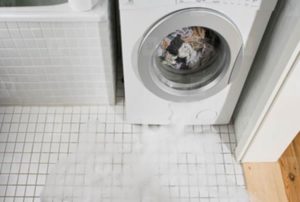 If you find that your washing machine is leaking from under the door, it is best to fix the problem immediately. You should not delay the repair by placing an empty container under the hatch or placing rags, over time the situation will only worsen - the leak will intensify. Let's figure out what to do if a malfunction is detected, what the causes of the leak may be, and how to deal with the problem of water leaking from the drum.
If you find that your washing machine is leaking from under the door, it is best to fix the problem immediately. You should not delay the repair by placing an empty container under the hatch or placing rags, over time the situation will only worsen - the leak will intensify. Let's figure out what to do if a malfunction is detected, what the causes of the leak may be, and how to deal with the problem of water leaking from the drum.
Dirt on the hatch door
To eliminate water leakage, you need to figure out what caused the leak. In some cases, the occurrence of a leak is not associated with a malfunction of the machine, but with banal contamination of the machine door. Limescale deposits accumulate on the glass of the hatch, in its lower part. If the formed layer is small, it does not in any way affect the normal functioning of the washer, but many housewives simply do not notice it and after a while the coating is firmly attached to the glass in the form of a lime crust.
The resulting layer will only thicken. When its thickness reaches a couple of millimeters, the door will not be able to fit tightly to the body of the washing machine, and the deposit will interfere with the normal closing of the hatch.
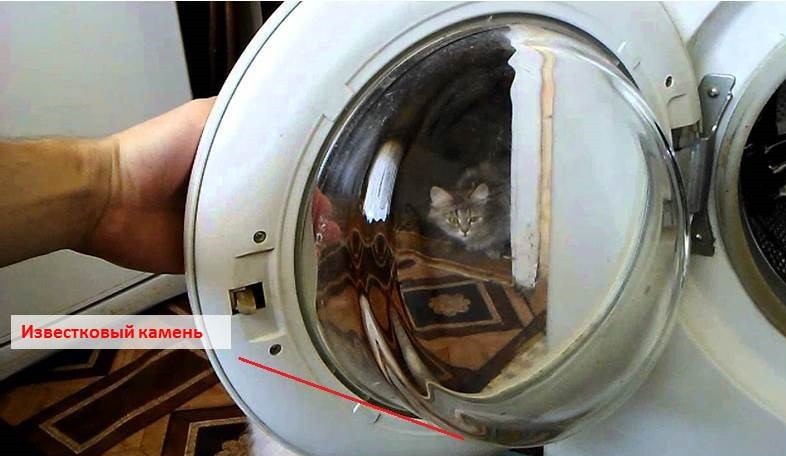
You can detect limescale build-up if you carefully examine the convex part of the hatch from below.
There is only one conclusion - due to the loose fit of the washing machine door to the sealing collar, water leaks from under the hatch. In this case, dealing with the problem will not be difficult. It is necessary to carefully examine the surface of the door, find where the limescale deposit has formed, and clean it off with a wire brush.When the bulk of the crust has been removed from the surface, the remaining plaque should be removed using an abrasive sponge or a regular rag. After cleaning the glass, the door will close without any problems and the machine will work normally again.
Damaged cuff
 In the vast majority of cases, water leaks from the washing machine precisely because of damage to the rubber seal located around the circumference of the hole for loading things into the drum. The cuff tends to wear out, small cracks, holes, and abrasions form on its surface. A damaged seal cannot perform its functions one hundred percent, as a result of which water leaks from the drum of the machine..
In the vast majority of cases, water leaks from the washing machine precisely because of damage to the rubber seal located around the circumference of the hole for loading things into the drum. The cuff tends to wear out, small cracks, holes, and abrasions form on its surface. A damaged seal cannot perform its functions one hundred percent, as a result of which water leaks from the drum of the machine..
In cases where water flows down the front wall of the washing machine, make sure that it is pouring out from under the hatch and not from the detergent tray. Small streams of water can come from the dispenser, go around the control panel of the machine in a thin stream, go down to the door and create the appearance that the source of the leak is located there.
If you are sure that it is the hatch door that is leaking water, it is worth examining the condition of the cuff. Leaks can form due to severe wear of the seal. When the hatch is closed, the system must be sealed, but if the sealing rubber has chips and cracks, this condition will not be met. The cuff does not have to be torn, in some cases it becomes wavy or too stiff, this also leads to leakage.
If, upon inspection of the sealing collar, damage is revealed, the rubber band should be replaced to eliminate the leak.
Cuff replacement You can produce it either on your own or by inviting a specialist.If you thoroughly study the process of installing a new rubber band and dismantling the old one, there will be no issues with replacing the element.
Sometimes leakage can be caused by a foreign object stuck between the hatch glass and the cuff, thereby disrupting the tightness of the connection. If the sealing ring is flexible enough and looks good, try simply cleaning the rubber itself, as well as the surface of the hatch in contact with it, from debris: lint, hair, particles of fabric, undissolved washing powder.
Problems with the door lock or hinges
In rare cases, water runs out of the washing machine door due to a manufacturing defect or careless use of the unit. The root cause of a hatch leak may be a deformed machine hinge. That is, the hinge mount was slightly bent, and it was this malfunction that caused the door to not close tightly. And a leaky connection between the hatch and the body, as we already understood, will inevitably lead to leakage.
When this is the case, fixing the situation is not difficult. The solution is to replace the loop with a new one. Especially savvy owners can try to determine where the deformation occurred and try to straighten the surface without resorting to replacing the part. To change the fastening you need to prepare two screwdrivers (Phillips and slotted) and an open-end wrench.
You can buy a loop in a specialized store or order it through online sites.
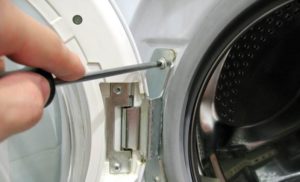 Also, the SMA can leak due to a malfunction of the lock blocking the door. The reason for the failure of the lock fastening will be purely individual, it all depends on the brand and model of your washing machine. In some cases, this is caused by a burst spring, in others by a torn gasket, causing an increase in play.It is better to entrust the search and elimination of the cause of the malfunction to a professional, so as not to waste a lot of personal time “digging” inside the machine. However, if you still want to fix the problem yourself, do the following:
Also, the SMA can leak due to a malfunction of the lock blocking the door. The reason for the failure of the lock fastening will be purely individual, it all depends on the brand and model of your washing machine. In some cases, this is caused by a burst spring, in others by a torn gasket, causing an increase in play.It is better to entrust the search and elimination of the cause of the malfunction to a professional, so as not to waste a lot of personal time “digging” inside the machine. However, if you still want to fix the problem yourself, do the following:
- using a Phillips screwdriver, remove the plastic panel located on the inside around the glass of the hatch door;
- loosen the door and disconnect it from the body;
- examine the lock, check the movement of the movable tongue;
- If you find wear on the elements or other damage, repair them.
If you notice that water is leaking from under the hatch of your automatic car, immediately take action. You can figure out the cause of the leak yourself or invite a technician who specializes in repairing washing machines. It is important to fix the problem immediately after detection, this will avoid more serious leaks and minimize the risk of electric shock.
Interesting:
2 reader comments
Add a comment Cancel reply
Categories
Washing machine repair


For buyers

For users

Dishwasher


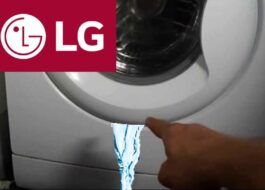

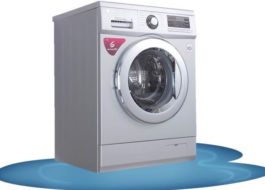
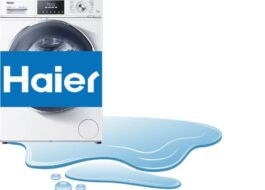
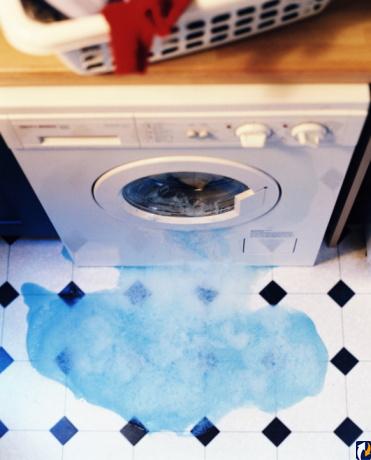










Thank you
Thank you.